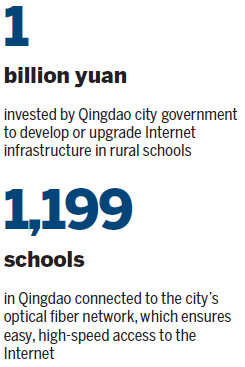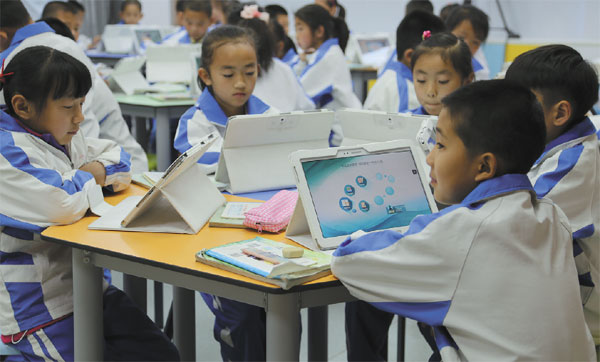Qingdao takes lessons online
City rises to top of the class with Internet initiative, Zhao Xinying and Xie Chuanjiao report.
The coastal city of Qingdao in Shandong province is developing its educational resources by promoting the use of information technology at all levels.
The move is part of a nationwide initiative launched by the Ministry of Education in 2012, with the goal of digitalizing more high-quality education resources to narrow the gap between different regions and schools.
|
Qingdao's status as a regional hub for shipment and finance requires international proffesionals, which gives rise to globalized education. Photos provided to China Daily |
In Qingdao, the city government has invested more than 1 billion yuan ($161.5 million) in recent years to develop or upgrade the Internet infrastructure of 736 primary and middle schools in its rural areas.
In 2014, the government gave funds to 31 schools in the city's least developed towns to ensure that students could access online education, as a way to reduce the education gap between the city's urban and rural areas.
Deng Yunfeng, head of the city's education bureau, said all 1,199 primary and middle schools in Qingdao have been connected to the city's fiber network, which ensures easy, high-speed access to the Internet. There is also at least one multimedia classroom in each of the schools.
In addition, the IT-based initiative is being expanded to cover the city's preschool education, as the city government requires all districts to upgrade their kindergarten facilities.
Smart education
The city encourages private companies to take part in the development of smart education facilities.
One such facility is the Qingdao Public Service Platform for Education Resources. Developed by a local private company, it was put into use last year.
The platform, which uses cloud-computing technology, now has its first batch of about 20,000 users. This year, more than 500,000 students and 50,000 teachers are expected to make use of the platform to access teaching and learning resources.

"IT-based education has not only made it easier for students to study on their own, but has also provided convenience to teachers, who can finish much of their work online, including preparing lessons, teaching, assigning homework to students and evaluating students," said Zhang Sifeng, an official in the city's education bureau who is in charge of education below university level.
Mu Yuncheng, director of the education equipment office of Jimo, a county-level city under Qingdao, said online education platforms have changed the traditional ways of teaching and research.
Mu said Jimo has set up 12 online education platforms and has supported the development of databases including recorded video lessons by the city's best teachers, exam questions and many other teaching resources.
With the recorded lessons uploaded onto the platform, teachers can also learn from the best teachers in the city while preparing their own lessons. The exam question database can also help teachers write their own test papers.
Skilled teachers are also invited to answer questions from other teachers on the platform to resolve common problems.
"The use of online education platforms makes it possible for us to break down barriers in sharing education resources," Mu said. "With the help of the platforms, we can now prepare for lessons in a more efficient way."
He Danping, a Chinese language teacher at Tianheng Middle School in Qingdao, said the online education platforms provide her the opportunity to learn from other teachers.
"Now, whenever I encounter questions or problems, help is just a click away," she said.
Efficient learning
The introduction of information technology has enriched teaching methods and added to the diversity of school curricula, which fosters student interest.
The students of Zhang Yan, a math teacher in Qingdao, are each equipped with computer tablets and Zhang often uses the devices to showcase mathematical concepts.
"With the help of IT tools, abstract mathematical concepts have been simplified and students find it easier and more interesting to learn," Zhang said.
Shan Xiubao, principal of Qingdao's Taizhizhuang Middle School, agreed.
"The old and boring ways of teaching have gone since online education systems were introduced," Shan said. "With the aid of these systems, students find classes more lively and their learning efficiency has therefore improved."
Jiang Liming, head of the Jimo Education and Sports Bureau, said learning methods have changed.
"Rather than being the passive receivers of knowledge as they used to be, more students are now becoming active learners and are enjoying the process of finding knowledge themselves," he said.
The practice of sharing the best teaching resources online has narrowed the gap between rural students and their urban peers.
By setting up workshops with more than 30 skilled teachers, Qingdao has made more than 1,200 high-quality lessons available online.
The effect of the practice is positive, according to education authorities in Jimo. During the past three years, the number of students from rural schools who were accepted to the country's top universities was almost the same as that from urban schools, local education authorities said.
Contact the writers at xiechuanjiao@chinadaily.com.cn
|
Students at Tongchuanlu Primary School in Licang district use tablet computers in class. |
|
Digital technologies are used in an astronomy laboratory at Xiangtanlu Primary School. |
(China Daily 05/23/2015 page6)

















